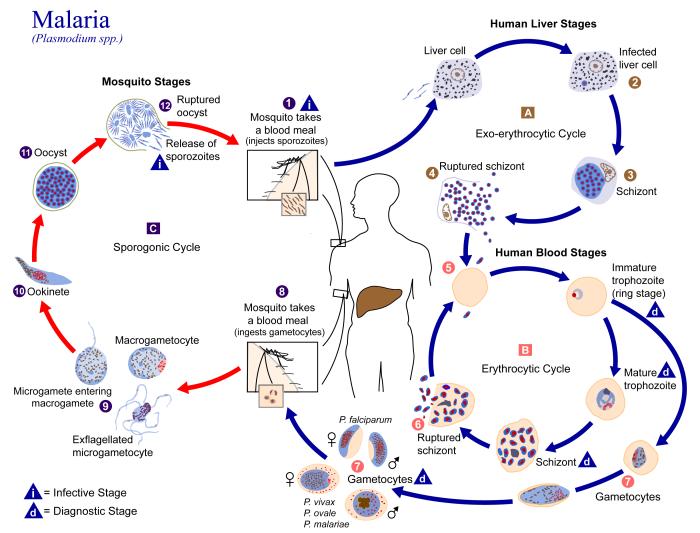Malaria
- Models of Plasmodium falciparum infected erythrocytes in in vitro cultures
- Engraftment process and infection dynamics in in vivo murine models.
- Epidemical models to tackle trasnmition and analyze antimalarial strategies.
INDIVIDUAL BASED MODEL AND SIMULATION OF Plasmodium falciparum in in vitro
CULTURES
Malaria or paludism is an acute or chronic disease caused by the protozoan parasite of the genus Plasmodium in human red blood cells. It is transmited via the vector mosquito of the genus Anopheles and still remains one of the most mortal diseases in the world, and means a great burden for the affected areas.

The projected eradication of the disease requires great effort and the combination of multiple strategies of prevention, control and cure. In vitro cultivation of the erythrocytic stages of P. falciparum is essential for the development of an effective treatment or vaccine. The actual methods in use for the in vitro propagation of the parasites are expensive, tenuous and not fully understood. There is a demand for improving the actual culturing techniques, and a model for the behavior of the culture systems would be an aid for this purpose.
Large-scale dynamic modeling of cell populations and subsequent computer simulations may provide the clues for a correct description of such a culture system, as it has thrown light over the global behavior of many microbial communities such as bacteria and yeasts. Many mathematical models for describing the dynamics of in vitro and vivo P. falciparum infected human erythrocyte populations have been carried out so far. They have proved to be useful for describing specific features, such as the effect of temperature variation on the infected cells population, or the assessment of cross-resistance to antimalarial treatments. However, such models based on differential equations leave some issues out of reach, in particular, those features that most strongly depend on individual traits or local processes.
Individual based Models (IbM) can introduce more realistic cellular models and describe local interactions. By using IbM, different aspects of the real culture system can be tackled one by one, thus more complexity can be introduced into the model.
The model and simulator INDISIM (INDividual DIScrete SIMulation) has been here adapted to tackle malarial in vitro cultures. The main entities are: the red blood cell and the merozoite -the invasive parasite form-. The central modelled processes are transport of nutrient and parasite spreading.
Components of the modelled system a) human red blood cells (RBCs) ; b) infected and healthy RBCs; c) culture systems (i) side and (ii) top views of a static culture, and (iii) static compared to (iv) agitated cultivation.

Further information here
Engrafment process and malaria infection in in vivo murine models
Moving on to a new topic, the IbM strategy can be adopted to model other relevant phenomena in the ambit of the parasite control, such as the study of in vivo infection dynamics and associated pathology in murine models. This methodology is compared with the continuous top-down apoproach. Further information on murine models can be found here.
Models in malaria fight strategy design
Models help decision making because they allow exploring the consequences of alternative actions prior to their application. The IbM methodology can also be used to tackle the spreading of malarial epidemics among the human population. Further information can be found here.
External collaborators:
- Dr. Domingo Gargallo-Viola, Grupo Ferrer, Barcelona (Spain)
- Dr. Iñigo Angulo Barturen, GlaxoSmithKline, Tres Cantos (Spain)
- Dra. Simone Ladeia Andrade, FioCruz (Brasil).
Related publications
Related conferences
Share: